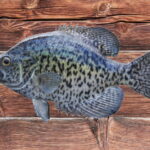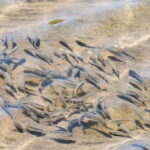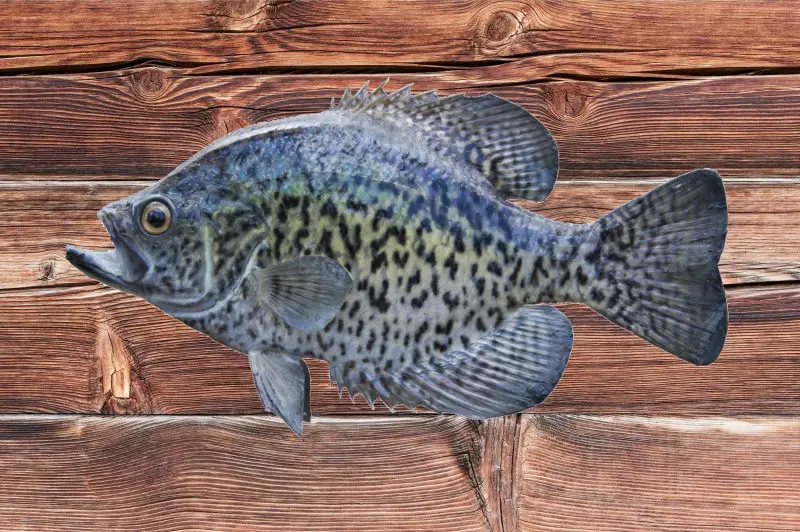Using the right bait is an excellent way to increase your chances of catching crappie. Wax worms are among the most popular live baits due to their creamy internals that emits a smell that attracts fish. Although most anglers use wax worms for fishing, you may not want to go that way without being sure if it’s a suitable bait for crappie.
Wax worms are good for crappie since they have a creamy internal scent that attracts these fish. Crappies are easily attracted to live baits like wax worms due to their smell and the fact that they are small enough for crappie to swallow easily.
In the rest of this article, I’ll discuss how to use wax worms for crappie fishing. You’ll know how to choose suitable worms, prepare them, and optimize your bait for the work. Let’s get started!
Note: most links in this article are Amazon.com Affiliate links, see Affiliate Disclosure, thank you.
How To Use Wax Worms for Crappie Fishing
Fishing is an art that requires patience and understanding the habits of the fish you’re trying to catch. Since you must use bait to lure the fish, it’s essential to have the right option and prepare it well.
Now that you can use wax worms for crappie, the next task is to know how to select and prepare them to increase your chances of making a catch.
Choose the Best Worms
If you just joined the fishing world, you may not know what to go for when looking for wax worms for your crappie fishing session. Luckily for you, here is how to choose the best:
- Go for a firm and fat wax worm: These worms have enough protein to attract crappie. The ones that have a whitish appearance also tend to do better as bait.
- Choose healthy wax worms: Look keenly at the worms’ bodies. Black spots are signs of disease, and you don’t want those in your bait.
- Consider the size: You can determine the best bait size through the length of crappie you want. Larger-sized wax worms work well for larger crappies and vice versa. It’s better to go for smaller wax worms fishing in a smaller river since such rivers mostly have small-sized crappies.
- Pick active wax worms: These are the ones that seem to be squirming around their container. The more active the waxworms are, the better for crappie fishing.
Prepare Wax Worms for Crappie Fishing
Once you have chosen the best worms, it’s time to prepare them for fishing. At this point, you need to have some rigging knowledge for successful fishing.
Here’s how to prepare a wax worm for crappie fishing:
- Prepare the hook: You need size eight to ten fishhooks to use with wax worms since most are plump and won’t fit on small-sized hooks or jigs.
- Rig the wax worm onto the hook: Pierce the worm’s midsection using the hook’s barb. Thread the wax worm onto the hook and push through until the barb protrudes from the other end.
- Ensure the wax worm can wriggle: Each end of the wax worm must be free to squirm on the hook. It’s this wriggling that attracts fish.
The Anmuka Fishing Freshwater and Saltwater Hook Pack (available on Amazon.com) is a suitable option. The pack has hooks of varying sizes. Therefore, you can choose a preferred size based on the size of the crappie and the wax worms you’re using.
If you plan on using multiple wax worms at once, thread them onto a hook to create a cluster, making it irresistible for the crappie to bite.
Optimize Your Bait for Crappie Fishing
Everything is ready; what’s left is to ensure the bait, including the hook or jig, is set for the task. Bait optimization increases your chance of luck.
Here are some tips for optimizing your wax worms:
- Keep them cool to maintain their plumpness
- Refrigerate them before use if possible
- Try dipping them in scented fish attractants or anise oil
The hook and the main fishing line also play a central role in ensuring that the fish will bite the bait. Therefore, they also need optimization in the following ways:
- Use a bobber: Adding a bobber to your rig is crucial if you want to monitor the bait’s movement in the water and detect when a crappie bites. The bobber lets you know when it’s the right time to retrieve it.
- Choose the right fishing line: Depending on where you’re fishing and if there are possible obstacles in the water, like trees or weeds, use a fishing line that won’t easily snap or break.
- Tie the hook on the line: Create a clinch note on the main fishing line and use it to tie the fishhook.
- Release a wire loop: Press the button on the clip-on bobber and slip the line through the released loop. This process allows the hook to hang at a good fishing depth.
- Add weight: If necessary, add a small weight to the main fishing line to ensure the bait hangs at the desired depth without floating on the water.
Cast Out Your Crappie Bait
It’s time to cast the bait into the water and wait for a bite from those hungry crappies.
Casting out doesn’t involve throwing the bait anywhere into the water. You must decide on a location that has signs of crappies. Some tips for identifying such sites include:
- Look for areas with cover and structures like logs, trees, or rocks.
- Look for spots where the water is deep enough for crappie to hide.
- Ensure you pay attention to where other fishermen are casting their bait.
Once you have found a spot, cast out the line at an angle toward it, you must keep your rod tip high and release the line smoothly.
Retrieve Your Catch
Retrieving involves reeling in the line to bring the bait back toward you. This process is where a bobber becomes useful, as it will alert you when it’s time to retrieve.
It’s time to retrieve your fishing tackle when the bobber dips below the water or moves in a jerky manner. This activity could be a sign that the crappie has taken the bait.
I recommend you reel it in slowly and wait for the crappie to fully bite on the hook before trying to pull it out of the water. It would be best if you retrieved it slowly and steadily, ensuring not to jerk the rod for fear of losing the hooked crappie.
Keeping Your Wax Worms Fresh For your Fishing Trip
Wax worms are excellent bait for crappie fishing, but only if you can keep them fresh. These creatures are live bait, and as such, they will not last long in storage. You need to take steps to ensure they remain plump and alive until you use them. Here are some tips for keeping your wax worms fresh:
● Store them in a cool, dark place: Wax worms are sensitive to light and heat and will die quickly if exposed to either of these elements. The best way to store them is in a cool, dark place like a refrigerator, but never freeze them.
● Use a bait container: A bait container with holes punched in the lid will allow the worms to breathe and will help keep them cool.
● Keep them moist: Wax worms need to stay moist, or they will die. If you are using a bait container, add some damp moss or newspaper to the bottom of the container to keep the worms from drying out.
● Check on them regularly: Wax worms can go from alive and wriggling to dead very quickly. Check on them regularly to ensure they are still fresh and alive.
Using wax worms for crappie fishing is a great way to catch these tasty fish. By following the tips above, you can ensure your wax worms stay fresh and live long enough to lure in a big catch.
Do Fake Wax Worm Catch Crappie?
While it is possible to catch crappie using fake wax worms, live bait is always going to be the best option. The smell of live bait is a top attractant for any fish species. Also, crappies are attracted to the movement of live bait, so they are more likely to bite at a live worm than a fake one.
Fake worms also have a tendency to get stuck on obstacles in the water, which can lead to lost bait and frustrated fishermen. If you are serious about catching crappie, live bait is always the way to go.
Here are a few tips to help when using fake or rubber wax worms:
● Add scent to your rubber wax worms: some wax worms will come presented, and while that can save you a step using a custom crappie scent typically works better.
● provide action to your offering: jigging wax worms with an ultralight fishing pole can attract and entice crappie to bite. Also, a very slow troll is a sure bet for more bites. Trolling into a school of crappie using a multi-pole combination of weighted wax worms and 1/8oz crappie jigs off your boat’s bow can be very effective.
● Use a small hook: Smaller hooks are less likely to get snagged on obstacles in the water. They also allow the fake worm to move more freely, making it more attractive to fish.
● Go for bright colors: Typically, fake wax worms come in a white color, but when you can get pink or chartreuse, you should give them a try. Brightly colored fake worms are more visible to fish and will be more attractive to them.
● Use a lightweight: Heavier fake worms will sink too quickly and may not move in the water the way you want them to. Choose a lightweight so you can control the movement of your bait.
● Try different sizes and shapes: Not all fish are attracted to the same size or shape of bait. Try different sizes.
For convince, we like pre-hooked rubber wax worms like these available on Amazon.com.

Also, Berkley Powerbait Honey Worms are a great addition to your tackle box. We like Powerbait because they are easy to use, keep well in your tackle box, and are multi-species friendly.

Conclusion
Wax worms are suitable crappie baits since they emit a smell that attracts these fish when pierced with a fishing hook. However, you must be careful to get the best wax worms for your fishing. Such worms must be healthy, active, and sizable based on the size of the crappie you want to lure.





